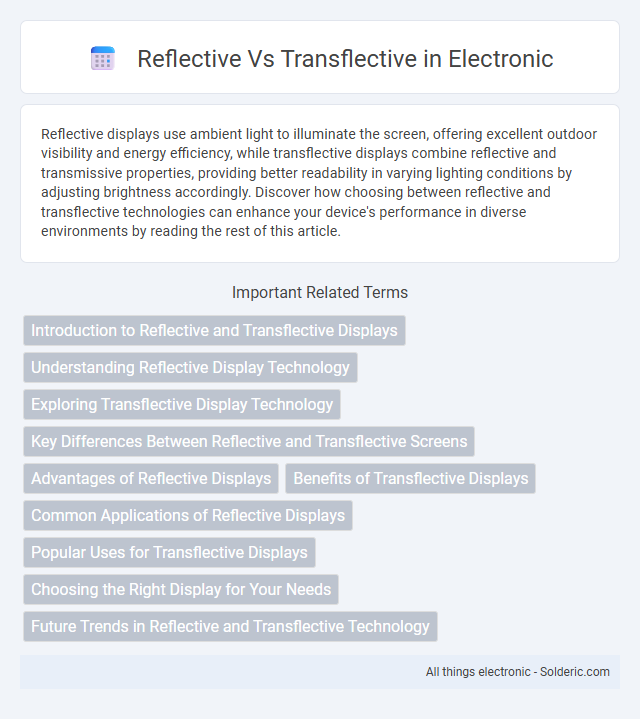Reflective displays use ambient light to illuminate the screen, offering excellent outdoor visibility and energy efficiency, while transflective displays combine reflective and transmissive properties, providing better readability in varying lighting conditions by adjusting brightness accordingly. Discover how choosing between reflective and transflective technologies can enhance your device's performance in diverse environments by reading the rest of this article.
Comparison Table
| Feature | Reflective Display | Transflective Display |
|---|---|---|
| Display Technology | Uses ambient light reflection for visibility | Combines reflective and transmissive technologies |
| Visibility | Excellent in direct sunlight | Good in sunlight and backlit environments |
| Backlight | Usually no or minimal backlight | Includes backlight for low-light conditions |
| Power Consumption | Low, due to minimal backlighting | Moderate, due to combination of lighting technologies |
| Color Quality | Limited, often monochrome or grayscale | Better color reproduction, supports color |
| Applications | Smartwatches, e-readers, outdoor devices | Smartphones, GPS devices, automotive displays |
Introduction to Reflective and Transflective Displays
Reflective displays use ambient light to illuminate the screen, making them highly energy-efficient and ideal for outdoor visibility. Transflective displays combine both transmissive and reflective properties, allowing for readability in various lighting conditions by using a backlight and ambient light reflection. Your choice between these display types depends on factors like power consumption, ambient lighting, and usability in diverse environments.
Understanding Reflective Display Technology
Reflective display technology uses ambient light to illuminate the screen, enhancing visibility in bright environments while reducing power consumption. This technology relies on a reflective layer that bounces external light back to your eyes, making it ideal for outdoor use and prolonged battery life. Understanding reflective displays helps you choose devices optimized for readability and energy efficiency in sunlight.
Exploring Transflective Display Technology
Transflective display technology combines the benefits of both reflective and transmissive screens by using ambient light to enhance visibility while maintaining backlight functionality. This hybrid approach ensures clear readability in direct sunlight and low-light environments, making it ideal for outdoor devices like smartwatches, handheld GPS units, and industrial equipment. Your experience improves with reduced eye strain and extended battery life due to efficient light utilization in varying lighting conditions.
Key Differences Between Reflective and Transflective Screens
Reflective screens rely primarily on ambient light to illuminate the display, resulting in superior visibility in bright environments and lower power consumption since they do not require a backlight. Transflective screens combine both reflective and transmissive technologies, allowing them to perform well in various lighting conditions by using ambient light when available and a backlight in low-light settings. Key differences include reflective screens offering higher energy efficiency and better outdoor readability, while transflective screens provide more versatility and consistent visibility across diverse lighting scenarios.
Advantages of Reflective Displays
Reflective displays offer exceptional readability in direct sunlight due to their ability to reflect ambient light, reducing power consumption as they do not require a backlight. These displays provide higher visibility and contrast in bright environments, making them ideal for outdoor devices such as smartwatches, e-readers, and industrial instruments. The energy efficiency of reflective technology extends battery life, which is crucial for portable electronics used in variable lighting conditions.
Benefits of Transflective Displays
Transflective displays combine the advantages of both reflective and transmissive screens, offering excellent visibility in bright sunlight and low-light conditions. These displays use ambient light to improve screen brightness and reduce power consumption, making them ideal for outdoor use and extended battery life. Their enhanced readability and energy efficiency make transflective technology a preferred choice for devices like smartwatches, GPS units, and outdoor digital signage.
Common Applications of Reflective Displays
Reflective displays are commonly used in applications requiring high visibility in bright environments, such as e-readers, smartwatches, and outdoor digital signage. These displays leverage ambient light to enhance screen readability without consuming much power, making them ideal for devices relying on battery efficiency. Your outdoor devices benefit significantly from reflective displays by maintaining clear visibility under direct sunlight.
Popular Uses for Transflective Displays
Transflective displays are widely used in outdoor devices such as smartwatches, GPS units, and handheld game consoles due to their excellent visibility in bright sunlight and low power consumption. These displays combine transmissive and reflective properties, ensuring your screen remains readable without excessive backlighting. Their durability and energy efficiency make them a popular choice for wearable technology and portable gadgets used in varying lighting conditions.
Choosing the Right Display for Your Needs
Reflective displays offer superior visibility in direct sunlight by using ambient light to illuminate the screen, making them ideal for outdoor use and low power consumption. Transflective displays combine the benefits of both reflective and transmissive technologies, providing clear visibility in various lighting conditions, including indoor and outdoor environments. Choosing the right display for your needs depends on your typical lighting conditions and power efficiency requirements, ensuring optimal readability and battery life.
Future Trends in Reflective and Transflective Technology
Future trends in reflective and transflective display technology emphasize enhanced energy efficiency and improved readability under direct sunlight, leveraging advancements in low-power LCDs and hybrid display materials. Transflective screens are evolving to integrate adaptive brightness controls and better color accuracy, optimizing user experience in varied lighting conditions. Your devices will benefit from these innovations, ensuring clearer visuals and longer battery life in outdoor environments.
Reflective vs Transflective Infographic

 solderic.com
solderic.com